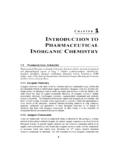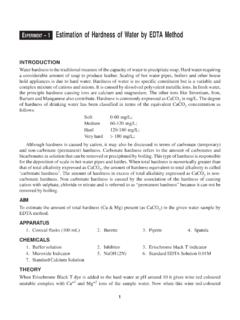Transcription of REGULATORY REQUIREMENTS FOR PHARMACEUTICAL PLANTS
1 CHAPTER 1 REGULATORY REQUIREMENTS FOR PHARMACEUTICAL PLANTS Introduction When we design a PHARMACEUTICAL plant we need to understand and follow the basic REGULATORY REQUIREMENTS for the construction of a PHARMACEUTICAL plant. These REQUIREMENTS are mainly divided into two categories namely - REQUIREMENTS related to good manufacturing practices currently followed in PHARMACEUTICAL industry. These are elaborately describe in the various international cGMP guidelines. REQUIREMENTS related to Factories Acts and Rules, which is a Central Act and the rules described separately by each state in India, for this work we have referred the rules specified by the state of Maharashtra.
2 In addition to these, there are specific rules and regulations related to following activities which should be referred separately by the reader , Regulation related to water and air pollution. Regulation related to handling and storage of inflammable materials etc. 1 2 | PHARMACEUTICAL Facilities: Design, Layouts and Validation REGULATORY REQUIREMENTS Related to Current Good Manufacturing Practices in PHARMACEUTICAL Industry The cGMP REQUIREMENTS are described in the various guidelines which deal mainly in the following categories, , (a) REQUIREMENTS related to surroundings.
3 (b) General REQUIREMENTS for PHARMACEUTICAL PLANTS . (c) REQUIREMENTS related to various departmental areas in the plant and (d) REQUIREMENTS related to special products. , sterile products. We will briefly deal with these guidelines below: (a) REQUIREMENTS Related to Surroundings of the Plant Part I of schedule-M of Drugs and Cosmetics Act- 1940 states the REQUIREMENTS in the following words- The factory building(s) for manufacture of drugs shall be so situated and shall have such measures as to avoid risk of contamination from external environment including open sewage, drain, public lavatory or any factory which produces disagreeable or obnoxious odour, fumes, excessive soot, dust, smoke, chemicals or biological emissions.
4 Only Indian cGMP guidelines specifically talk about surroundings of PHARMACEUTICAL plant. All other international guidelines talk in terms of General REQUIREMENTS and different plant areas. In the next section, we will review the General REQUIREMENTS related to PHARMACEUTICAL PLANTS . Comment Many countries have industrial zone concepts, , a particular type of industry planned by design in a particular part of the country, province or even city. When deciding this, the basic REQUIREMENTS of the industry are taken into account and hence selection of location for the organization is simplified.
5 Presently in India also such industrial zones are coming up , Information Technology industry is coming up in Hyderabad, Bangalore, and Pune etc. Similarly PHARMACEUTICAL industry is coming up in places like Baddi in Himachal Pradesh, more similar PHARMACEUTICAL zones are expected come in more places in India. Some of the major points to be considered in these cases are - Land cost, water sources, supply of electric power, extremes of climate like heavy rain, extremes of temperature, earthquake proneness, transport facilities for material REGULATORY REQUIREMENTS for PHARMACEUTICAL PLANTS | 3 and men, Availability of trained or skilled man power, Labour and industrial legislations, cost of living, etc.
6 (b) General REQUIREMENTS for PHARMACEUTICAL PLANTS After reviewing the leading international cGMP guidelines, we can summarize the same in the following points. 1. PHARMACEUTICAL PLANTS must be located, designed, constructed, adapted and maintained to suit the operations to be carried out. 2. Their layouts and design must aim to minimize the risk of errors and permit effective cleaning and maintenance, in order to avoid cross-contamination, built up of dust or dirt and in general any adverse effect on the quality of the product and safety of the personnel.
7 3. The Canadian guidelines are similar to above 1 and 2 but adds one point or Orderliness in the plant and specifically talks about preventing contamination of drug and addition of extraneous materials to the drug. It also talks about regular maintenance of the PLANTS to prevent deterioration of the premises and finally says that the Ultimate objective of all endeavours is product quality. Comment PHARMACEUTICAL PLANTS must be designed so that they must meet following REQUIREMENTS . They should be easy to clean, maintain and operate.
8 These factors must be taken into account while designing the plant layout and detailed exercises should be carried out for men and materials movement, considering the manufacturing flow charts of the products to be manufactured. Zigzag movements of men and materials should be avoided as far as possible. Avoiding cross contamination and mix-ups is the main idea in designing the pharma PLANTS and working out their layouts. Layouts include equipment, subsection, section, department etc. Equipment or workstation is the basic unit of operation , a compression m/c for tablets, a sifter, a capsule filling m/c etc.
9 For avoiding cross contamination and mix-ups the flow of materials is to be considered as primary aspect and other aspects like, storage of intermediate materials at different stages of processing and packing and also the separation of air handling unit must be considered to avoid contamination of materials. Manufacturing PLANTS must be situated in such an environment which protect all the manufacturing processes by minimizing the risk of contamination of / Intermediate and finished products. 4 | PHARMACEUTICAL Facilities: Design, Layouts and Validation Comment Protecting manufacturing processes in plant from contamination involves control on the environment.
10 A careful planning of HVAC system must be done to avoid contamination. Following points must be considered while doing this , segregation and clearly defining the scope of individual air handling unit so that only one product is being exposed in that area at any time of operation. Duct and filter cleaning procedures must be well defined and documented. The HVAC system details must be worked out very critically, these include details like, Temperature Humidity Differential pressure Air changes per hour Class of air etc.





